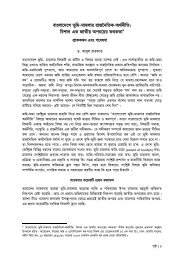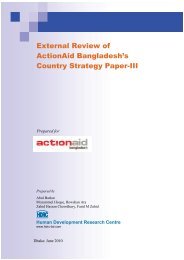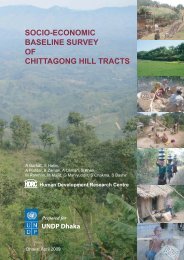08. Costing Essential Services Package An Issue Paper
08. Costing Essential Services Package An Issue Paper
08. Costing Essential Services Package An Issue Paper
Create successful ePaper yourself
Turn your PDF publications into a flip-book with our unique Google optimized e-Paper software.
<strong>Costing</strong> <strong>Essential</strong> <strong>Services</strong> <strong>Package</strong>: <strong>An</strong> <strong>Issue</strong> <strong>Paper</strong> 21<br />
other major areas of ESP (e.g. Child health care, Communicable disease control) as well as the<br />
sub-areas of ESP (e.g. unsafe abortion, safe motherhood, neonatal care, etc.).<br />
Streatfield et.al. (1997) have conducted a focussed study “Increasing Financial Sustainability of<br />
Family Planning <strong>Services</strong> in Bangladesh”. The main thrust was that if the family planning<br />
program was to approach sustainability in the future, in addition to increasing funding, there<br />
must be increases in cost recovery and improvements in cost containment. The study observed<br />
that the current reliance on a home visit program was an expensive way to deliver oral pills and<br />
condoms. The main study question was: how can pricing of contraceptive supplies be used to<br />
encourage couples to go out of their homes to seek family planning services? The overall<br />
conclusion of the study was that the Government without negative consequences could impose<br />
some form of differential pricing for the FP Program; and appropriate pricing policies can be<br />
used by both the GoB and the NGOs to encourage clients to be more active in seeking family<br />
planning services, contributing to the programs sustainability in the long run (Streatfield et.al.<br />
1997).<br />
A detailed cost analysis study of major areas of ESP – family planning, maternal health, child<br />
health, control of communicable disease and limited curative care – based on comprehensive<br />
analysis of work pattern by categories of staff has been conducted by Barkat. et.al.(1999). The<br />
study initially intended to cover FP-MCH only; however due to the coincidence of timing of the<br />
study with that of preparation of HPSP, the component-wise ESP coverage was extended. This<br />
study provides work pattern and cost related information for thana level (facility) and below. The<br />
sample size was restricted to 4 unions in 4 thanas. The study provides interesting insights into<br />
the way staff (different categories) use their time at the primary care level. The pattern of time<br />
use has been analysed by service delivery mechanism (home visit, clinic), by type of activities,<br />
and by ESP components. Using basically a bottom-up approach (although some elements of<br />
top-down allocation were used), annual local level cost of delivering all the health and family<br />
planning services and disaggregated cost (total and average) by ESP components have been<br />
estimated. In addition, the estimates of costs have been shown for all RIBEC input categories<br />
and by the type of budget and of cost components. Besides, the estimates of fixed costs and<br />
average costs have also been obtained (Barkat et.al. 1999). The relative high utility of the<br />
methodology and findings of the study is evident in Ensor’s costing exercise using existing data<br />
(Ensor 1999).<br />
The most recent relevant study on relative unit cost differences for a sample of Thana, District<br />
and Medical College Hospitals is the study conducted by Rannan-Eliya and Somanathan<br />
(November 1999) for the Health Economics Unit, MOHFW. The study provides many useful<br />
methodological constructs. One of the major findings reported in the study was that the unit<br />
costs, in terms of costs per in-patient admission and outpatient visit, of Thana Health Complex<br />
is considerably higher than at the District Hospital despite a less complex case mix. In addition,<br />
the survey findings contain useful data on recurrent and capital expenditure of THCs, which can<br />
be used for the analysis of ESP costing by facility levels.






